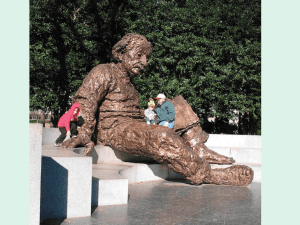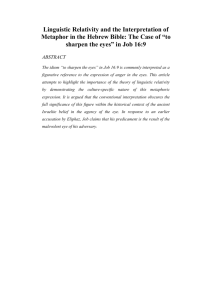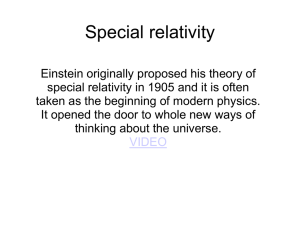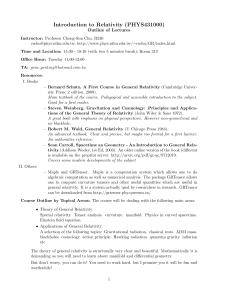Relativity theory - High Energy Physics at Wayne State
advertisement
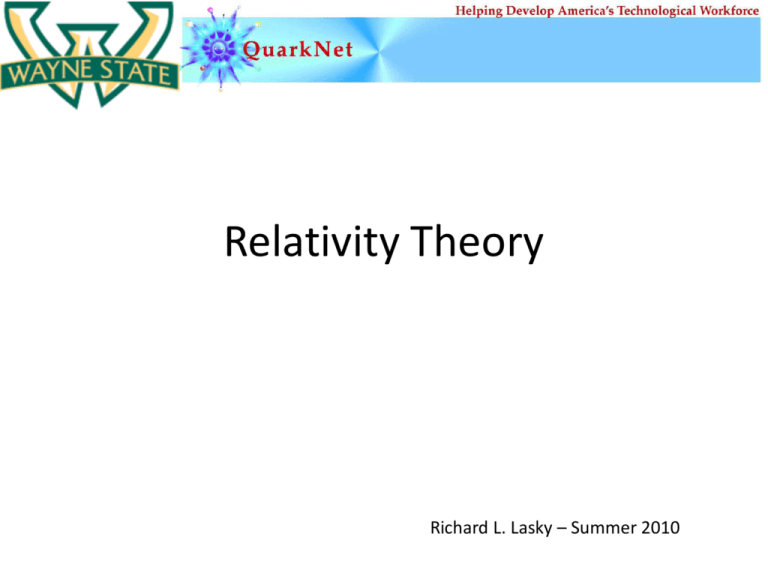
Relativity Theory Richard L. Lasky – Summer 2010 Relativity Theory • Einstein’s Theory of Relativity is mostly known for it’s assertion that time travel is possible, but in reality this theory encompasses much more. The theory itself is actually split into Special Relativity and General Relativity Special Relativity • Special Relativity is based upon two postulates: 1. The laws of physics are the same for all observers in uniform motion relative to one another 2. The speed of light in a vacuum is the same for all observers, regardless of their relative motion or of the motion of the source of the light http://videos.howstuffworks.com/sciencechannel/33305-time-special-relativityvideo.htm http://www.metacafe.com/watch/523678/two _postulates_special_relativity_1_of_5/ Time Dilation • Time Dilation and Time Travel: Moving clocks are measured to tick more slowly than an observer’s “stationary” clock http://www.youtube.com/watch?v=KHjpBjgIM Vk&feature=player_embedded http://www.scivee.tv/node/3007 Simultaneity of Events • Simultaneity of Events: It is impossible to say with absolute certainty that two events occur at the same time if the events occur in different spaces. The perception of when each takes place depends on the observer http://www.youtube.com/watch?v=wteiuxyqt oM&feature=player_embedded http://www.scivee.tv/node/3025 Length Contraction • This result of special relativity is only relevant when looking at objects moving at speeds above 30,000,000 m/s • At that speed, objects appear to be shorter than they what they appear as when stationary or moving at a slower speed • What follows is the idea that if an object has mass, it cannot move at the speed of light. Hence the speed of light, 299,742,458 m/s, is the universal speed limit for anything with physical mass • Anything moving at that speed is pure energy • So, E = mc² http://www.youtube.com/watch?v=Un1UZpzA 3wQ&feature=related General Relativity • General Relativity is the geometric theory of gravitation put out by Einstein to argue against Newton’s Law of Universal Gravitation • Newton’s law was based on the idea that gravity could move faster than the speed of light, which Einstein obviously found to be false • Einstein stated that gravity is instead a property of the geometry of space and time, also called spacetime http://www.youtube.com/watch?v=Op8yZYxNGc&feature=player_embedded General Relativity • Gravitation Time Dilation: time moves more slowly in gravitational fields than it does in fields lacking an gravitation pull. The mass of the effect is proportional to the strength of the gravity • Beams of light are bent as they travel through gravitational fields, which explains the existence of black holes • Frame-Dragging: a rotating object with mass will drag along the spacetime that is around it. One example is light moving in the same rotational direction as the object will appear to move faster to a distant observer than will light moving in the opposite direction http://www.youtube.com/watch?v=ZgvjwEmK Y6o&feature=player_embedded Black Holes • Stephen WilliamHawking, CH, CBE, FRS, FRSA (born 1942)is a British theoretical physicist • In the late 1960s, he and his Cambridge friend and colleague, Roger Penrose, applied a new, complex mathematical model they had created from Albert Einstein's general theory of relativity • Hawking also suggested that, upon analysis of gamma ray emissions, after the Big Bang, primordial mini black holes were formed • Classically, it can be shown that information crossing the event horizon of a black hole is lost to our universe http://dsc.discovery.com/vi deos/stephen-hawkingsuniverse-black-holetime.html http://www.youtube.com/ watch?v=S6srN4idq1E&fe ature=related http://www.youtube.com/watch?v=P5_Msrdg 3Hk&feature=related

